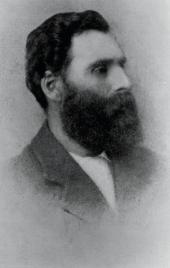
Jean-Louis Légaré was born in St. Jacques, Montcalm County, Quebec on October 25, 1841, the son of François-Xavier Légaré and Julie Melançon. Early in his life, he left for adventure and to find employment in the USA. By 1869, he became involved with the fur trade as a clerk at Fort Totton, North Dakota; this led to many subsequent independent business ventures and community development efforts. His Métis employer, Antoine Ouellette, hired Jean-Louis to establish a business in the Wood Mountain area of southern Saskatchewan. In 1870-71, he organized his first camp at Little Woody, 15 miles south of Willow Bunch. In the spring of 1871, while on a trading expedition to sell furs, he collaborated with George Fisher, from St. François-Xavier, in establishing a store east of Wood Mountain. On April 15, 1873, Jean-Louis married Marie Ouellette, the daughter of François Ouellette and Josephte Bottineau. On October 5, 1875, Marie gave birth to their only child Albert Joseph. Tragedy struck this new family on December 4, 1876, when Marie Ouellette passed away after falling off a horse while she was visiting her father at Fort Walsh. Jean-Louis took her remains to Lebret, where she was buried. He never remarried.
In the spring of 1877, Sitting Bull and his tribe of Sioux numbering 4,000 came to the Wood Mountain area after the Battle of the Little Big Horn. Initially, Sitting Bull and his people traded with Jean-Louis. However, with the severe depletion of the buffalo, the Sioux were soon facing starvation. Jean-Louis, being a generous and compassionate man, provided money and supplies for the destitute group. By 1881, the Canadian and American governments wanted Sitting Bull and his tribe to return to their native land and establish a reserve, but the Sioux chief commented that he would only trust the word of his friend, Jean-Louis. As a result, both federal governments entered into an agreement with Légaré to enlist his help. In July, Sitting Bull and his people returned to Fort Buford, where he surrendered to US authorities. A bill for compensation of goods and services was sent to the Canadian and American governments, but Légaré was never fully repaid.
In 1882, he moved to Willow Bunch and constructed the first wooden house in the area with a private water line; this led to the establishment of the Willow Bunch waterworks. In 1884, he switched to trading horses for cattle in Manitoba; this began the establishment of a cattle industry in Willow Bunch. By 1886 the first school opened in Willow Bunch, of which Légaré was a trustee. In 1888 he traded more horses, this time for dairy cattle, and then began a cheese factory. This business enterprise failed by 1894 due to economic distress in the area. Being a devout Roman Catholic, in 1899 he donated 80 acres of land to the Saint-Ignace-des-Saules parish, and a church, rectory, convent and cemetery were built. From 1898 to 1918, Légaré held the position of first postmaster in Willow Bunch, as well as the offices of Justice of the Peace and census enumerator. He died On February 1, 1918, at 76 years of age and was buried in Willow Bunch. The Jean-Louis Légaré Regional Park was established in 1960, and in 1970 the Historic Sites and Monuments Board of Canada erected a plaque commemorating his life and achievements.
Louise-Marie Légaré